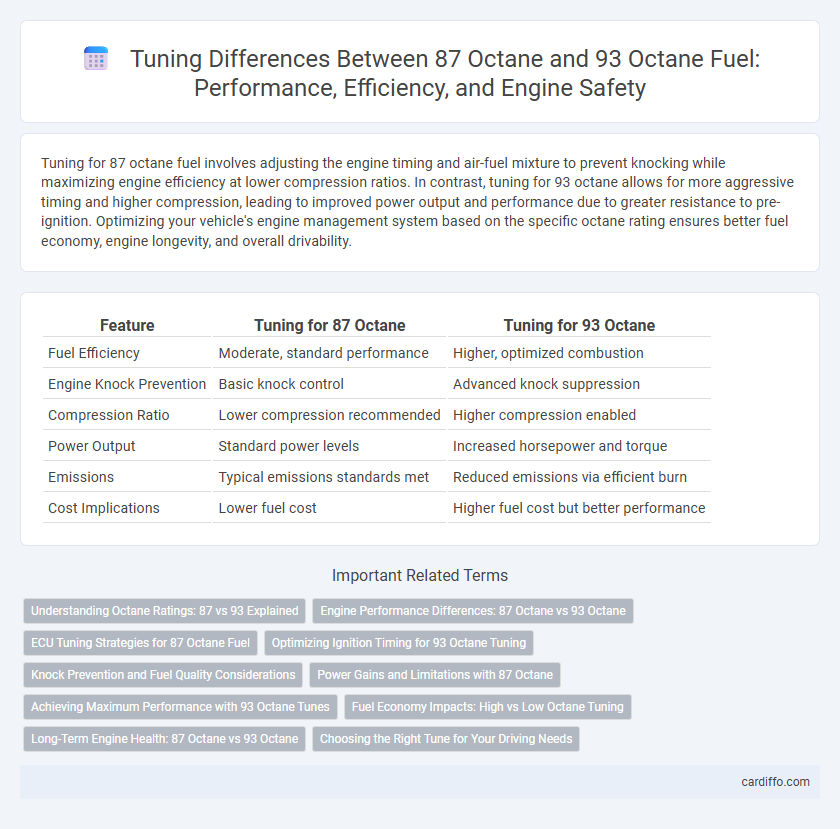Tuning for 87 octane fuel involves adjusting the engine timing and air-fuel mixture to prevent knocking while maximizing engine efficiency at lower compression ratios. In contrast, tuning for 93 octane allows for more aggressive timing and higher compression, leading to improved power output and performance due to greater resistance to pre-ignition. Optimizing your vehicle's engine management system based on the specific octane rating ensures better fuel economy, engine longevity, and overall drivability.
Table of Comparison
| Feature | Tuning for 87 Octane | Tuning for 93 Octane |
|---|---|---|
| Fuel Efficiency | Moderate, standard performance | Higher, optimized combustion |
| Engine Knock Prevention | Basic knock control | Advanced knock suppression |
| Compression Ratio | Lower compression recommended | Higher compression enabled |
| Power Output | Standard power levels | Increased horsepower and torque |
| Emissions | Typical emissions standards met | Reduced emissions via efficient burn |
| Cost Implications | Lower fuel cost | Higher fuel cost but better performance |
Understanding Octane Ratings: 87 vs 93 Explained
Octane ratings measure a fuel's ability to resist engine knocking during combustion, with 87 octane serving as the standard for regular gasoline and 93 octane classified as premium fuel. Engines tuned for 87 octane fuel are optimized for moderate compression ratios, while those designed for 93 octane can utilize higher compression to achieve greater power and efficiency. Selecting the appropriate octane rating matching the engine's tuning prevents knocking, enhances performance, and ensures durability.
Engine Performance Differences: 87 Octane vs 93 Octane
Tuning for 87 octane fuel often results in increased engine knock sensitivity and reduced compression ratios, leading to lower power output and engine efficiency compared to tuning for 93 octane. Engines optimized for 93 octane benefit from higher spark advance and improved combustion stability, which enhances overall performance and fuel economy. The higher resistance to knock in 93 octane fuel allows for more aggressive timing, maximizing horsepower and torque without risking engine damage.
ECU Tuning Strategies for 87 Octane Fuel
ECU tuning for 87 octane fuel involves optimizing ignition timing and air-fuel ratios to prevent engine knocking under lower compression pressures compared to 93 octane. Strategies include retarding spark timing and enriching the mixture to accommodate the lower resistance to pre-ignition, enhancing engine reliability and efficiency. This tuning approach balances performance and emissions while protecting engine components from detonation typically encountered with 87 octane fuel.
Optimizing Ignition Timing for 93 Octane Tuning
Optimizing ignition timing for 93 octane fuel involves advancing the timing to maximize the higher knock resistance and energy content, enabling more efficient combustion and increased power output compared to 87 octane. Engines tuned for 93 octane can safely operate with more aggressive ignition timing without the risk of engine knock or detonation, resulting in improved throttle response and fuel efficiency. Precise tuning of ignition timing parameters allows vehicles to fully leverage the benefits of premium fuel, enhancing performance while maintaining engine reliability.
Knock Prevention and Fuel Quality Considerations
Tuning for 87 octane requires careful knock prevention strategies since lower octane fuel has a higher tendency to cause engine knocking, which can damage pistons and reduce performance. Vehicles tuned for 93 octane can operate with advanced ignition timing and higher compression ratios, maximizing power output while minimizing knock risk thanks to the fuel's superior resistance to pre-ignition. Fuel quality considerations include ensuring consistent octane levels and avoiding ethanol blends that may alter combustion characteristics and affect knock thresholds in both tuning scenarios.
Power Gains and Limitations with 87 Octane
Tuning for 93 octane fuel maximizes power by allowing higher compression ratios and more advanced ignition timing, resulting in improved engine efficiency and performance. In contrast, tuning for 87 octane restricts power gains due to its lower resistance to knocking, which forces more conservative ignition timing and compression settings to prevent engine damage. While 87 octane remains cost-effective and widely available, its limitations constrain peak power output and throttle response compared to higher-octane fuels like 93 octane.
Achieving Maximum Performance with 93 Octane Tunes
Tuning for 93 octane fuel optimizes combustion timing and air-fuel ratios to unlock higher engine performance and efficiency compared to 87 octane. Higher octane fuel resists knocking, enabling more aggressive ignition timing and increased compression, which boosts horsepower and torque. Advanced 93 octane tunes leverage these properties to maximize power output while maintaining engine reliability and fuel economy.
Fuel Economy Impacts: High vs Low Octane Tuning
Tuning for 87 octane fuel often results in reduced fuel economy due to less efficient combustion and increased engine knocking risk, leading to conservative ignition timing. In contrast, tuning for 93 octane allows for more aggressive ignition timing and higher compression ratios, optimizing combustion efficiency and improving fuel economy. Higher octane fuel enhances engine performance and thermal efficiency, directly impacting miles per gallon and reducing fuel consumption during varied driving conditions.
Long-Term Engine Health: 87 Octane vs 93 Octane
Tuning for 93 octane enhances long-term engine health by reducing knock and pre-ignition risks, which can cause internal damage over time. Engines calibrated for 87 octane often experience more frequent ignition timing retardation to compensate for lower fuel stability, potentially leading to increased carbon buildup and decreased efficiency. Optimizing ignition settings for higher octane fuels like 93 promotes cleaner combustion and sustained performance, extending engine lifespan and reducing maintenance costs.
Choosing the Right Tune for Your Driving Needs
Tuning for 87 octane fuel prioritizes cost-effectiveness and compatibility with standard engines, offering reliable performance for everyday driving without the need for high compression settings. In contrast, tuning for 93 octane fuel enables advanced ignition timing and increased power output, ideal for high-performance vehicles and aggressive driving styles that demand maximum engine efficiency. Selecting the right tune depends on balancing fuel availability, vehicle specifications, and desired performance outcomes to optimize engine longevity and fuel economy.
Tuning for 87 Octane vs Tuning for 93 Octane Infographic

 cardiffo.com
cardiffo.com